LET'S COMPARE SOME POPPIES - PAPAVER APULUM & PAPAVER RHOEAS
Yeah, let's do it. It could be fun. In an educational, geeky way.
I photographed a ton of poppies this spring. I took portraits of a single flower and photographed groups of them peaking from the surrounding greenery. I photographed through the macro lens and took quite a few wide-angle shots. I spent so much time with poppies that I almost started talking to those lovely flowers.
All the poppies I encountered, which means all the plants you'll see and read about in this post, belong to two species - Papaver rhoeas and Papaver apulum.
I also included a few small arthropods to spice up this botanical post with a bit of fauna.
These two shots show the two Papaver species standing proudly next to each other, like they never would in nature. One of them is considerably taller than the other, and I never saw the two species growing really close to each other. The intensely red flower on the left is Papaver rhoeas, commonly known as the common poppy, red poppy, or field poppy. The paler one on the right is the smaller Papaver apulum. Some internet sites state that the common name of Papaver apulum is the peacock poppy, while the majority mention only the scientific name - decide for yourself how to interpret this information.
Here you can see two photographs that show the center of each flower. On the left is Papaver apulum, while on the right, you can take a good look at the Papaver rhoeas. I used the flash to evenly illuminate all the little details of the anthers and the pistils. The direct, harsh light is good enough for a picture that wants to get the flower's anatomy thrown in your face, but without any atmosphere or sense of art. It's a kind of image that feels like a list of words, a shopping list or something, instead of being a little visual poem. In the following two shots ...
... the flowers were photographed in the low ambient light at dusk. Papaver apulum is on the left again, and Papaver rhoeas is on the right. Everything looks more elegant here. Less brightness - more magic. Low light makes the shooting more challenging, but the results can be very rewarding.
Here you can see a lovely trio of Papaver rhoeas flowers surrounded by many flower buds, while in the following set of four photographs ...
... you can admire a bunch of Papaver apulum flowers slapped by the wind.
Most Papaver apulum present in this post were photographed on a windy day, so they may look more disheveled than common poppies. If you compare the two above shots, you'll notice how the flowers change their shape and position due to the wind.
These two shots are here to let you compare the flower buds. The smaller Papaver apulum is on the left - the bigger common poppy (Papaver rhoeas) is on the right. The developing flowers are well hidden, encased in pretty large green and hairy sepals that form something that looks like an alien pod, a thing from another world lost in the depths of the universe.
At some point, the pod, pressured by the spreading petals, will crack and show the vivid interior. You can see the birth of a poppy flower in the above picture.
The photograph on the left shows the Papaver apulum, the one on the right Papaver rhoeas.
When the fully developed flower spreads its petals, the sepals will fall. In these two photographs, Papaver rhoeas is on the left, and Papaver apulum is on the right.
On one occasion, late in the afternoon ...
... I came across a scene that looked like the birth of a bushcricket at first sight.
The soft, humid insect was coming out of an old exoskeleton hooked on the Papaver rhoeas flower bud.
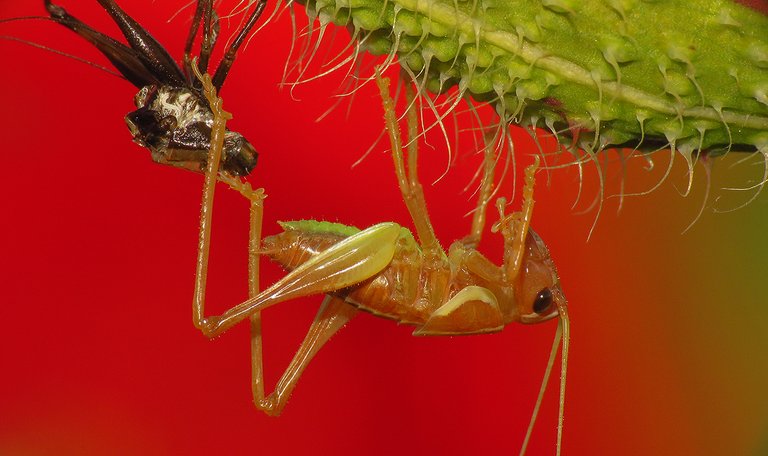
The developing nymph has grown too big for its old exoskeleton.
I photographed this process many times, but never in such a photogenic, colorful environment.
The red petals of the nearby flowers provided an amazing background.
The scientific name of this bushcricket species is Eupholidoptera schmidti.
The family is Tettigoniidae, of course. All bushcrickets belong to that large and varied family.
In these two photographs, Papaver apulum is on the left, and Papaver rhoeas is on the right. You probably noticed that flower buds are in both species situated on bent stems, while the flowers aren't.
The flower is at the top of a vertical stem.
As the flower is getting closer to spreading its petals, the stem slowly straightens until reaching the vertical position. In the above picture, Papaver apulum is on the left again, and Papaver rhoeas is on the right. Again.
The following two photographs ...
... show two flower buds of the same kind. They are both Papaver apulum flower buds. The one on the left is bent, the other one is straight, which means considerably closer to a fully developed flower.
Papaver rhoeas flower buds in various stages of development display a nice amount of diversity. For example, some are more rounded, while others tend to a more elongated shape. In this set of five photographs, you can explore the small differences and admire the individuality of each bud.
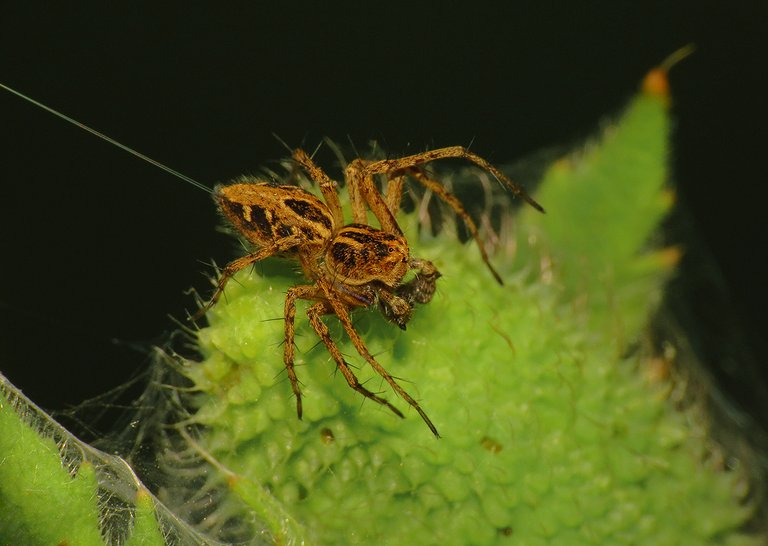
This is the Oxyopes heterophthalmus, a spider from the Oxyopidae family.
The Oxyopes heterophthalmus was resting on the field poppy flower bud. The flower bud in question was a pretty peculiar one. It was connected to the leaves and the central stem of the plant by the silk produced by another spider.
Cheiracanthium punctorium, commonly known as the yellow sac spider, a species from the Cheiracanthiidae family, builds large, sac-like structures that envelop parts of vegetation, turning them into a solid shelter.
If you take the time to explore all the details in the above photograph, you may notice the legs of Cheiracanthium punctorium hidden in the silky sac.
The flower bud, with its elegantly bent, sinuous stem, looks like an interesting sculpture.
Observing the shapes and colors in nature is quite similar to exploring an art gallery or museum.
For a few seconds, a thread of silk stretching from the Oxyopes heterophthalmus' abdomen to the neighboring plant was visible. When I took the following photograph ...
... the thread wasn't there anymore.
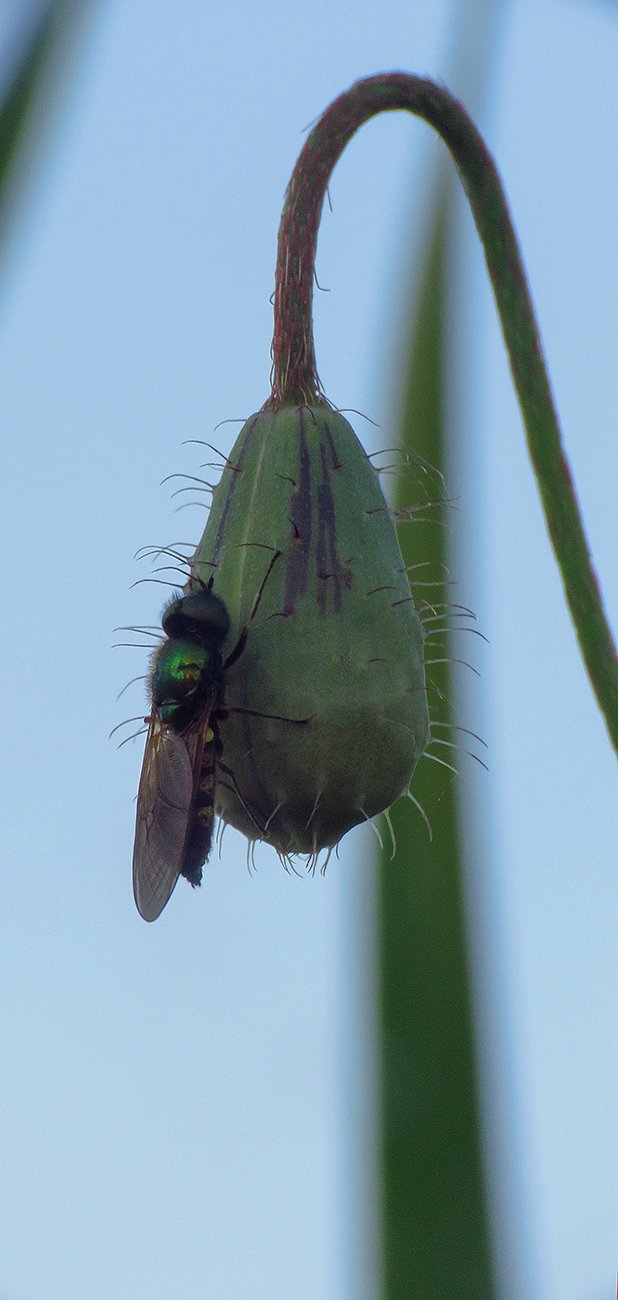
Here you can see an iridescent fly resting on the Papaver apulum flower bud. The scientific name of this species from the Stratiomyidae family is Chloromyia formosa.
These two shots show two Papaver rhoeas flowers photographed up close in ambient light. The photograph on the left was taken at dusk, the one on the right, around noon.
Here we have two photographs that show the same common poppy from different angles. In the following picture ...
... you can admire a bunch of lovely Papaver apulum flowers on a windy April afternoon. The wind was blowing pretty hard when the photograph was taken.
Here you can see a trio of neatly aligned Papavers of the same kind.
Each of these two photographs shows the same two Papaver rhoeas flowers. The left photograph was taken in ambient light only, while to get the one on the right, I used the small, built-in flash of my camera to illuminate the central parts of the flowers.
Here you can compare two groups of poppies peaking from the surrounding vegetation. A group of common poppies (Papaver rhoeas) on the left, and a group of peacock poppies (Papaver apulum) on the right.
Psilothrix viridicoerulea is a beetle from the Melyridae family that often feeds on pollen inside the poppy flowers. Here you can see the beetle posing on the petals of the Papaver apulum flower, beautifully illuminated by the subdued light at dusk. In the following photograph ...
... I came a bit closer to the flower and the insect resting on one of its petals.
In this shot, the focus is on the anthers, pistil, and the beautiful iridescence in the center of another Papaver apulum flower photographed at dusk. In the following photograph, you can see the same flower, but ...
... but the context is quite different. It's a wide shot that, besides showing the Papaver apulum in its environment, nicely conveys the evening atmosphere.
This interestingly shaped capsule is the fruit of Papaver rhoeas. As the flower's ovary, the basal part of the pistil, develops into fruit ...
... the anthers and petals fall. That applies to both Papaver species shown in this post, but ...
... but I photographed only the fallen petals of Papaver rhoeas.
The vivid red petals scattered around the juicy green vegetation make a nice seasonal decoration.
A decoration that doesn't last long, though. The fallen petals shrivel and then dissolve pretty fast.
These two shots can let you compare the fresh, young fruits of Papaver apulum and Papaver rhoeas. Papaver apulum is on the left, and Papaver rhoeas is on the right. I used the flash here.

Here you can see a Papaver apulum fruit whose stem is partially enveloped by the petals of the neighboring Papaver apulum flower. The following two photographs ...
... show the fruits photographed in ambient light. Papaver rhoeas is on the left, and Papaver apulum is on the right. On that same evening ...
... I came across this gorgeous combination of the fruit and flower forming what looks like a very elegant sculpture.
I saw some crazy stuff this spring among the poppies.
Here you can compare another pair of poppy fruits. Papaver apulum is on the left, and Papaver rhoeas is on the right.
This tryptich shows a recently formed Papaver rhoeas fruit still surrounded by anthers. Each of the three shots was taken with slightly different camera settings.
Here you can see yet another portrait of a Papaver rhoeas fruit that looks like a head with a nicely designed little hat on its top.
In these two shots, you can compare the flowers, for a change. On the left is Papaver rhoeas - guess who is on the right?
This wide shot shows Papaver apulum flowers on a windy afternoon. Their petals were fluttering in the wind. The following triptych...
... shows more flowers of the same kind.
What can I tell you here? Just another shot that shows the Papaver apulum fruits and flowers next to each other, that's all.
These two shots show the same Papaver rhoeas flower bud almost ready to spread its petals and lose its sepals. The photograph on the left was taken with the flash, the other one without it.
Here you can see the Papaver rhoeas flower buds in the light of the late afternoon.
This triptych shows the Papaver apulum flower buds in various stages of development. I mean, the three shots show only two flowerbuds. The photographs on the left and the right show the same flower bud photographed with the flash and in ambient light. The central photograph shows another flower bud of the same species, and it was taken with the flash.
Here you can see the Runcinia grammica, a spider from the Thomisidae family, posing on the Papaver rhoeas flower bud. This is a very small, juvenile spider.
This Papaver apulum flower bud was photographed against the blue background of the sky.
The following links will take you to the sites with more information about the protagonists of today's post. I found some stuff about them there.
https://en.wikipedia.org/wiki/Papaver_rhoeas
https://www.cretanflora.com/papaver_apulum.html
http://www.pyrgus.de/Eupholidoptera_schmidti_en.html
https://en.wikipedia.org/wiki/Oxyopes_heterophthalmus
https://www.naturespot.org/species/broad-centurion
https://en.wikipedia.org/wiki/Psilothrix_viridicoerulea
https://en.wikipedia.org/wiki/Runcinia_grammica
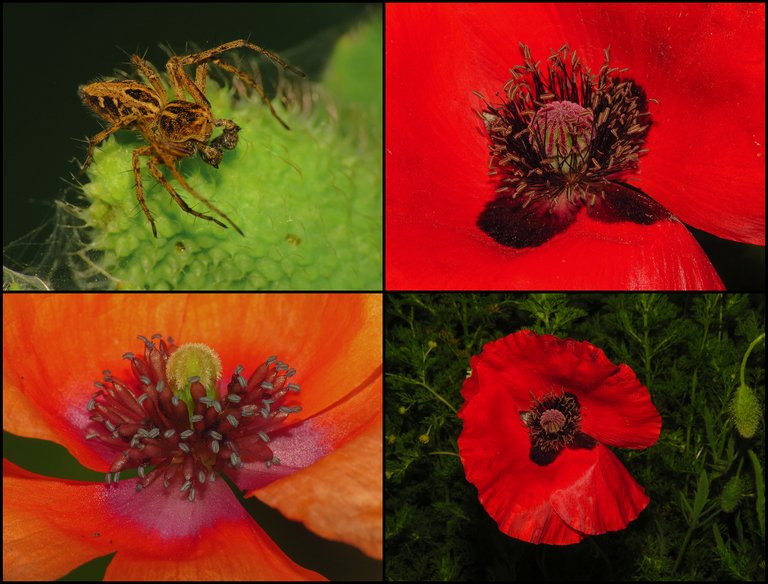
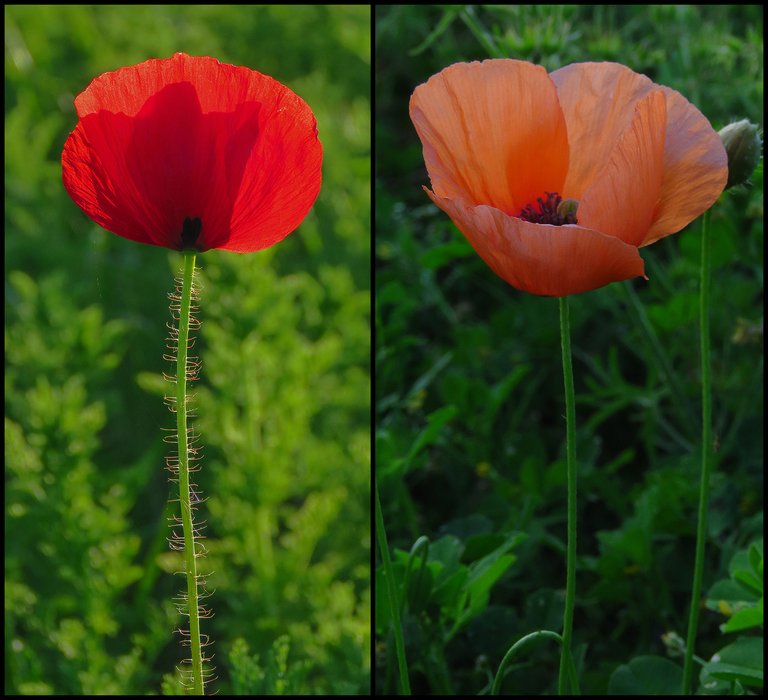
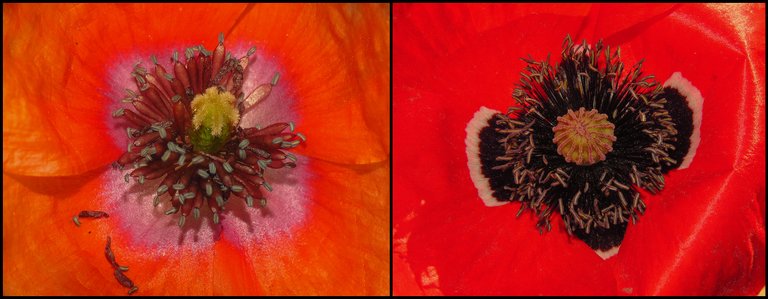
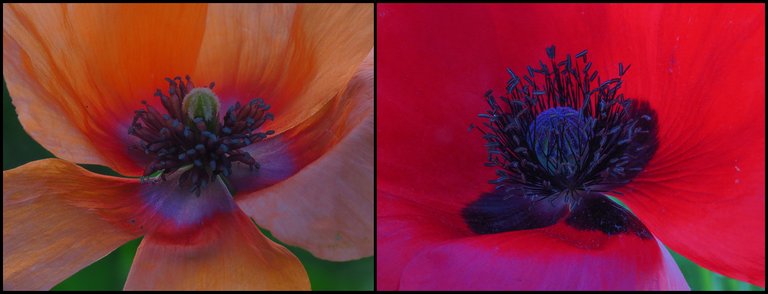

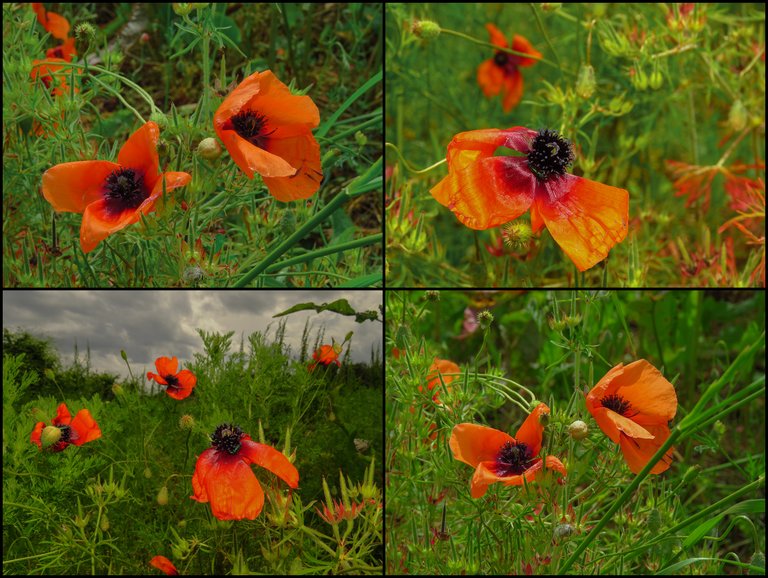
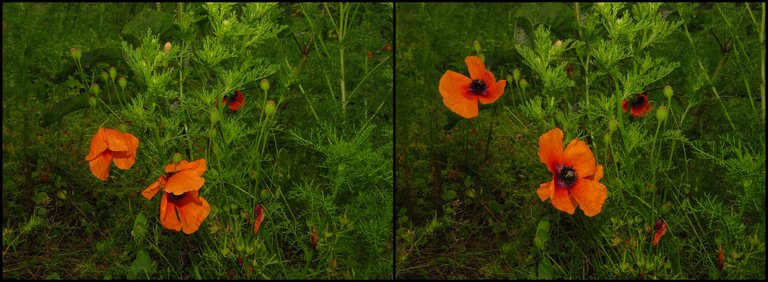

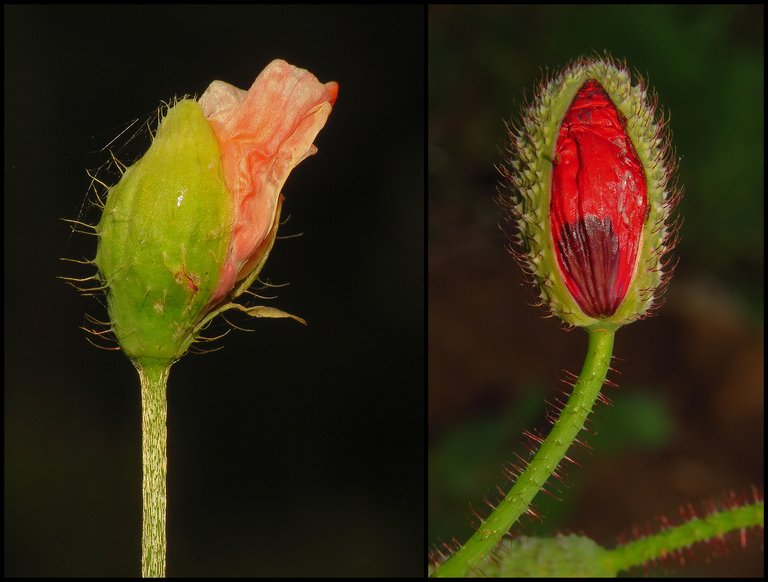
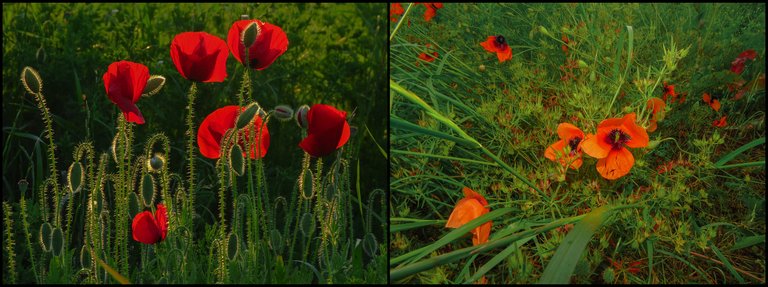

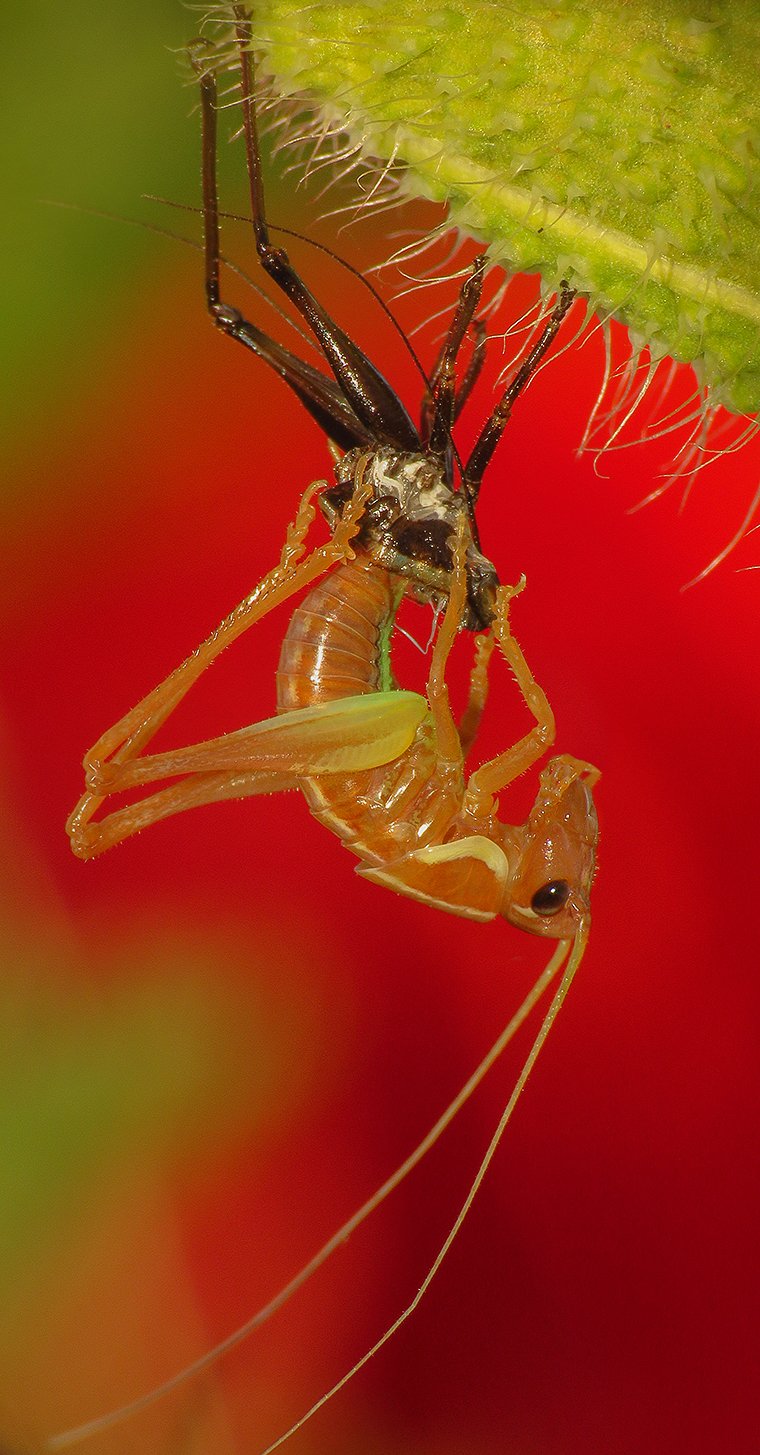
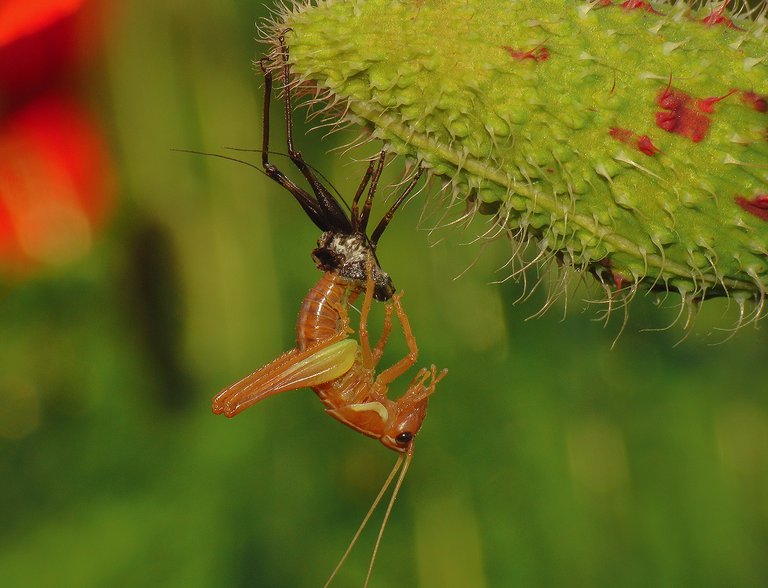
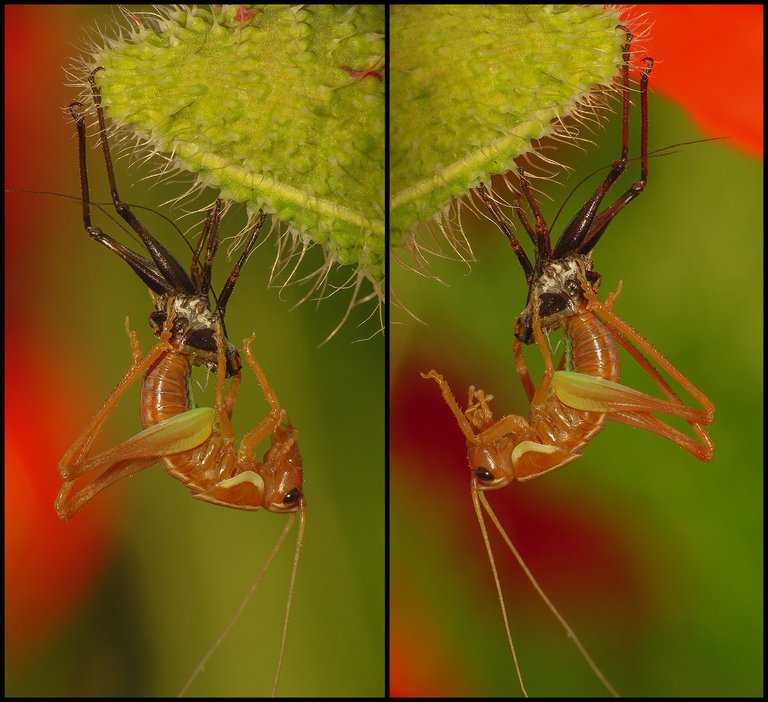
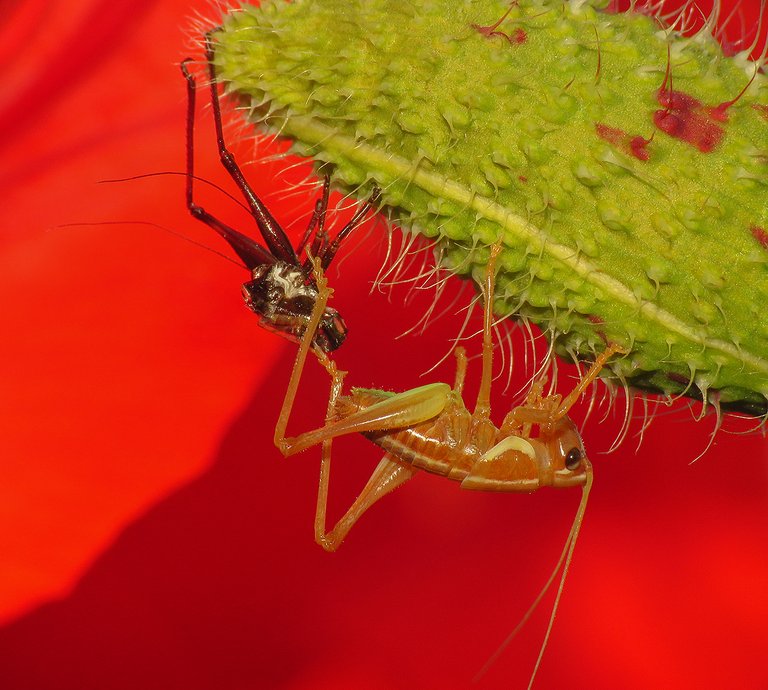
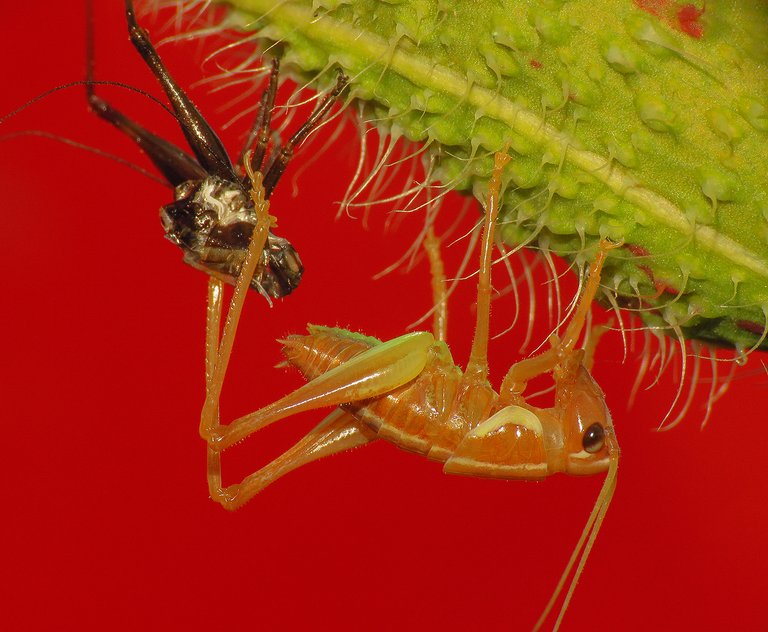








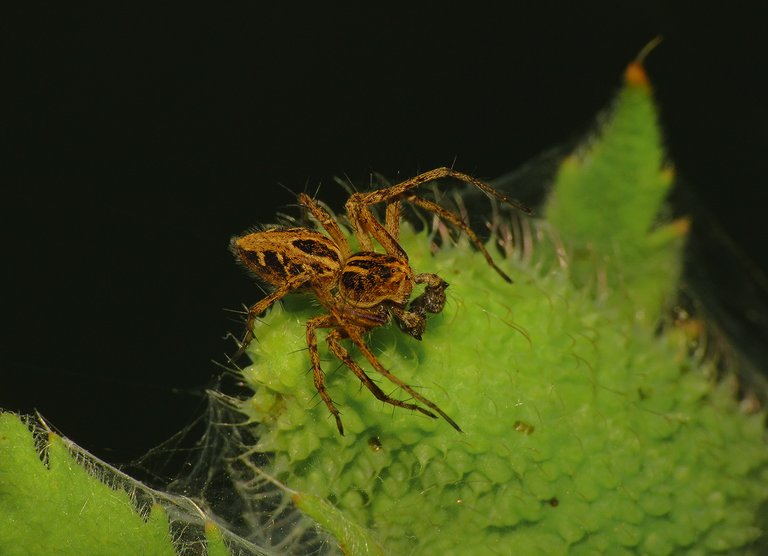
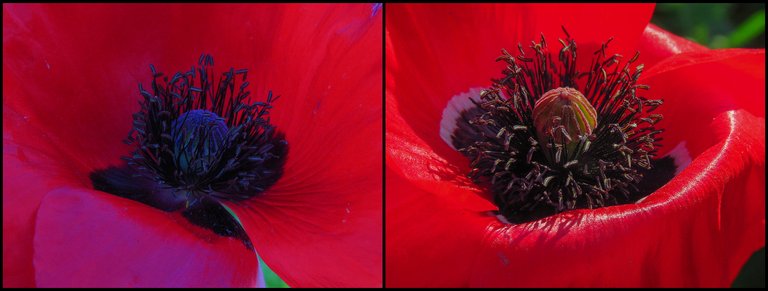





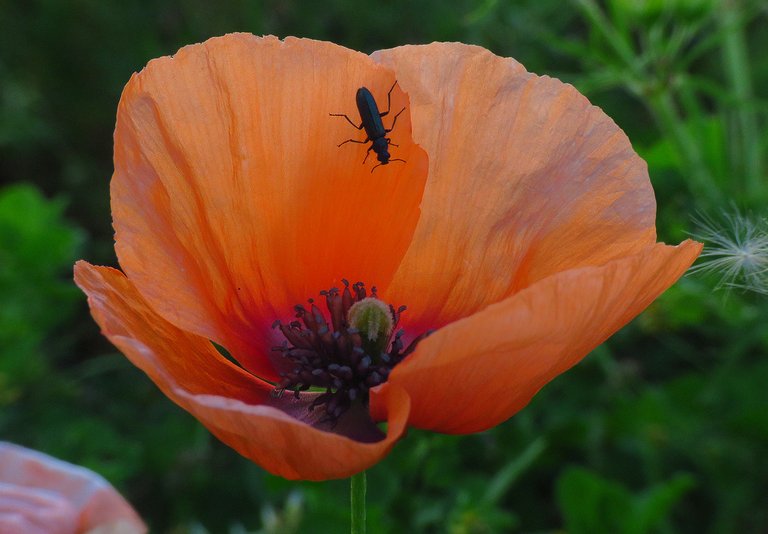


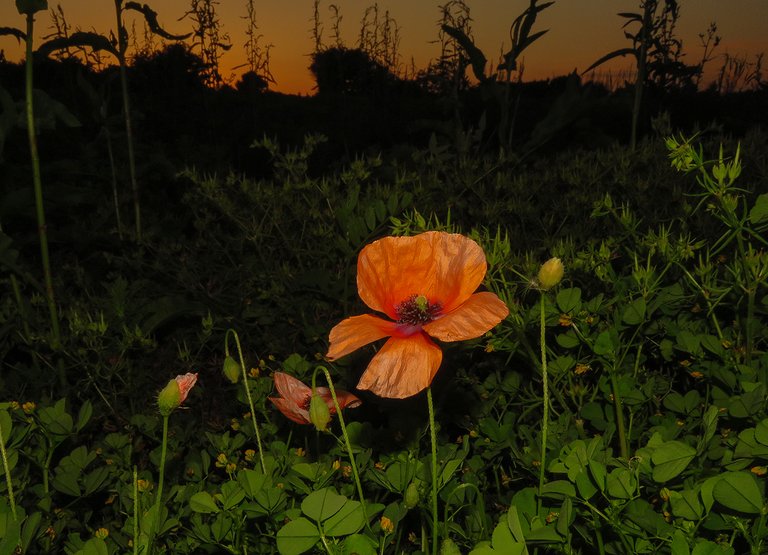
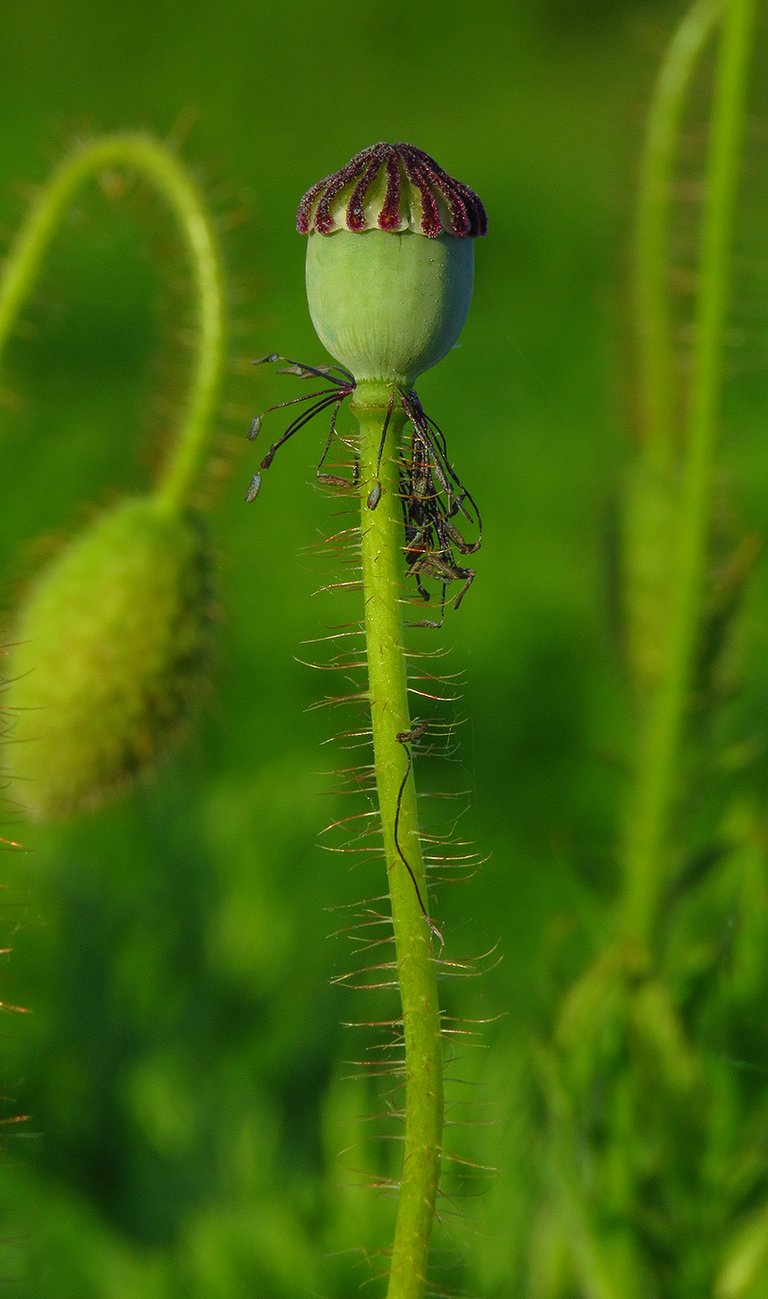
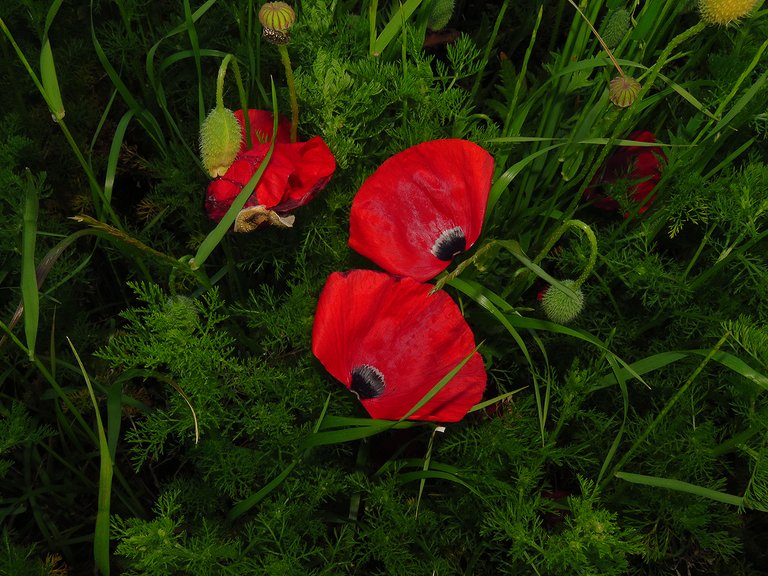
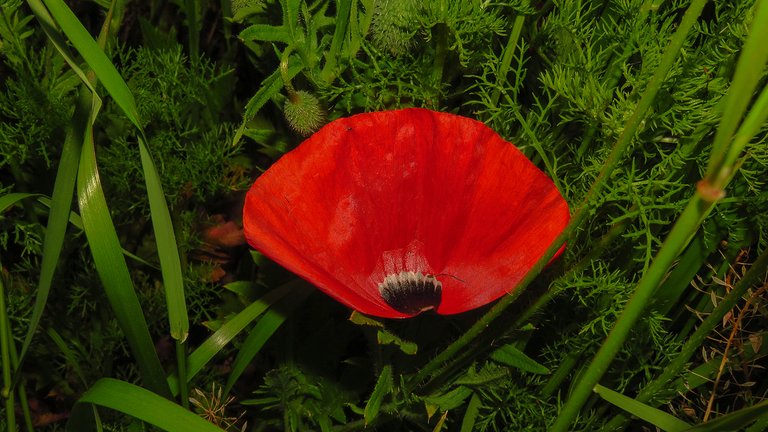

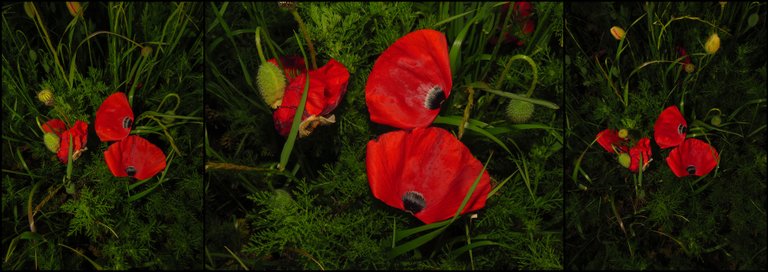
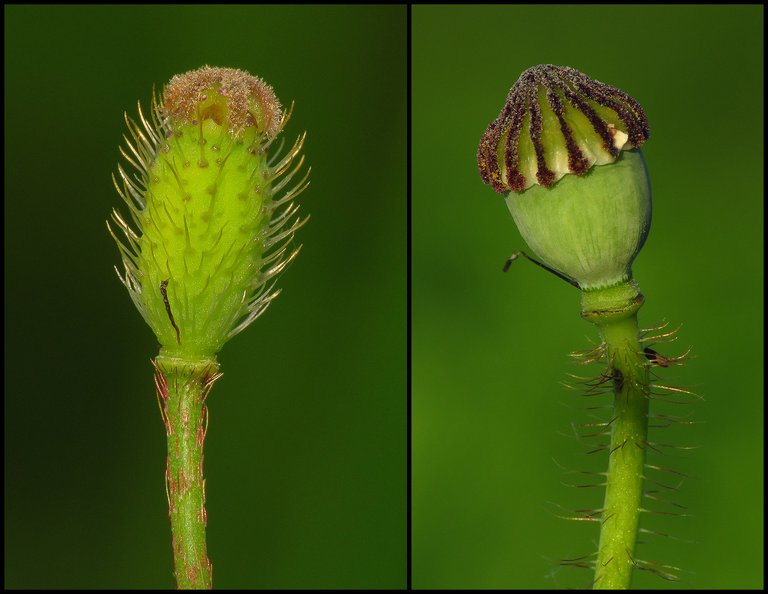



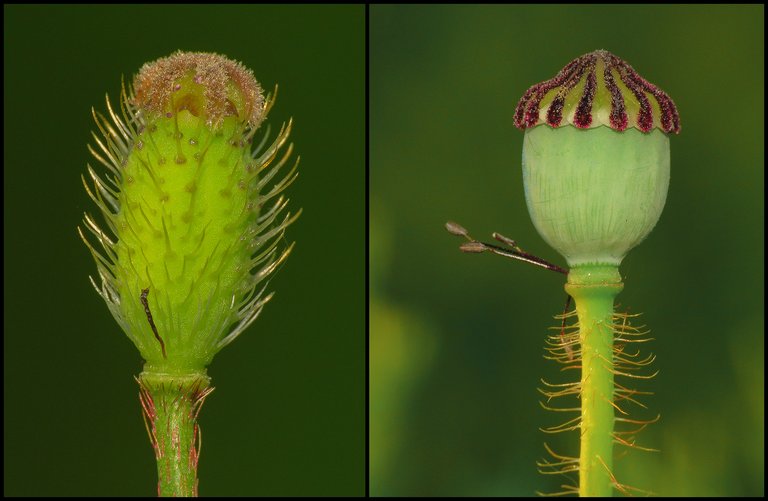

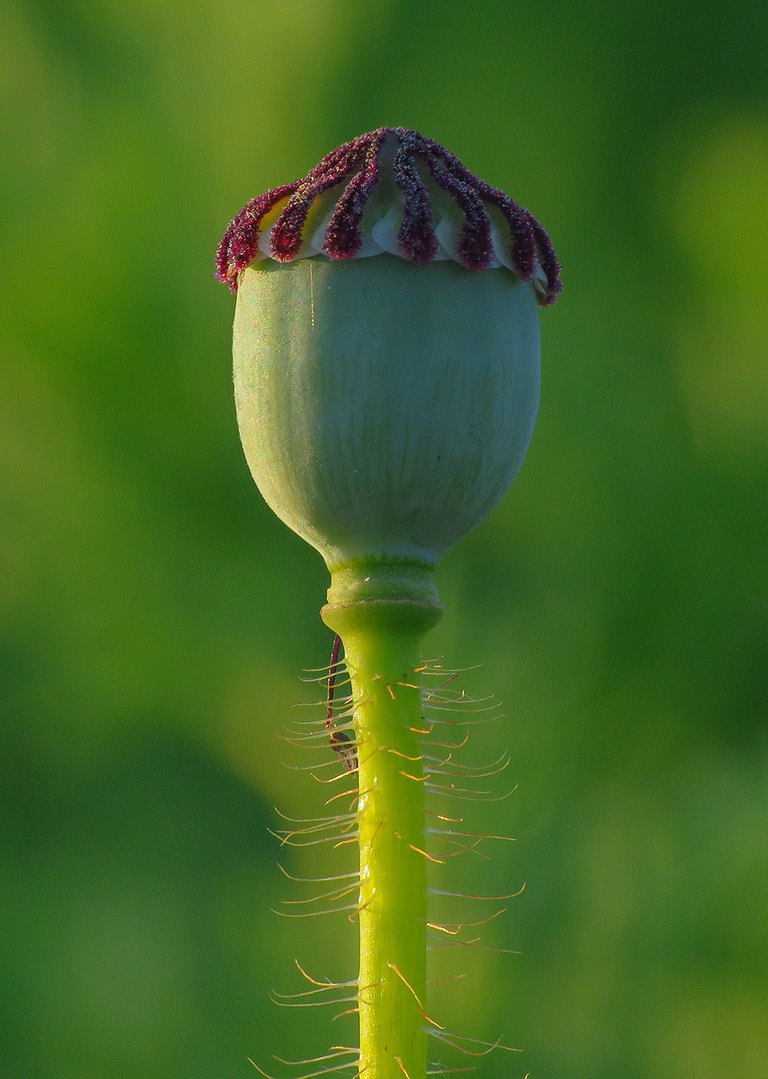






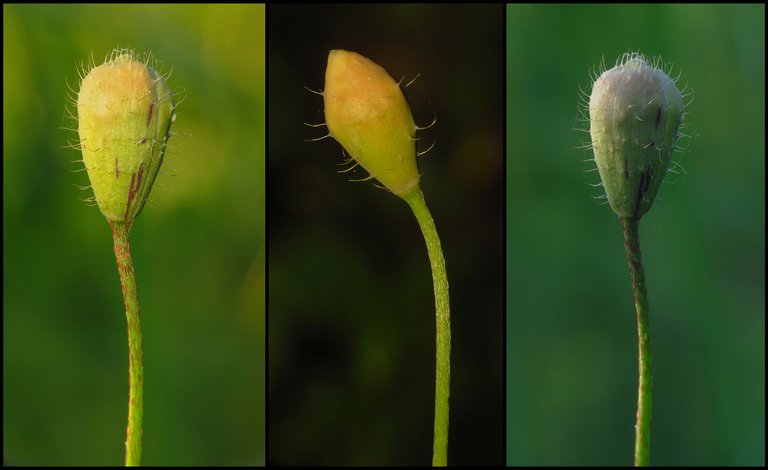
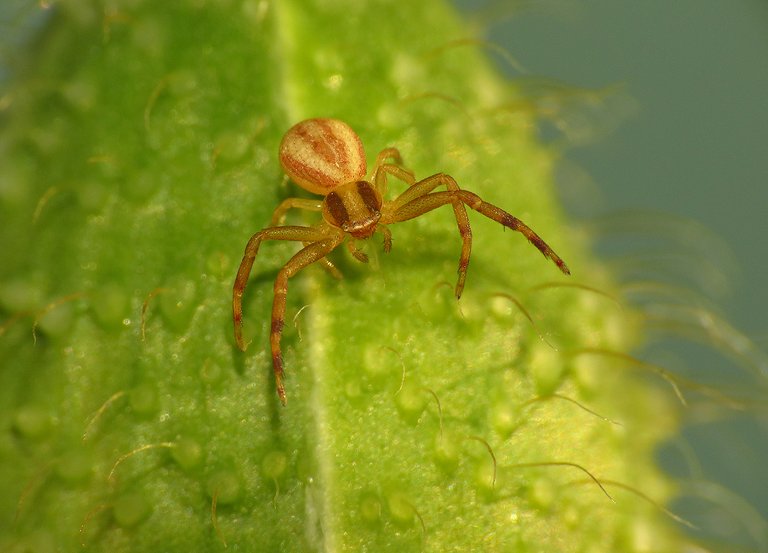


Beautiful photos and pleasing to the eye. Perfect shot :)
🙂
:)
🎉🎉🥳 Congratulations 🥳🎊🎊
Your post has just been curated and upvoted by Ecency
keep up the good work
Join us on the Ecency Discord
I remember there were poppies in your past shoots. They keep reminding me of the first world war: In Flanders Fields...

🌹Thanks for the poem. 🙂
It's written by John McCrae,a Canadian surgeon who helped in the first worldwar in Belgium.
It remembers me about the absurdity of war...
It's a great poem. The first verse with poppies has a great impact, and I found myself remembering it without trying to memorize anything.
I really want to ask if your a professional photographer because the way this photos are been captured is so beautiful.
I'm not a professional photographer, but I spent quite a few years learning about photography through books and the Internet.
These red flowers are beautiful to look at, and the centerpiece scene you photographed is amazing.
What a lovely and detailed post! The photos are amazing, and I enjoyed learning about the two poppy species and the tiny creatures around them. Nature is truly beautiful! Thanks for sharing!
So much flowers 😵💫😂😂
How does one remember the names of all of them?
Even if they're just two main species😂😂😂
Lovely pictures as always though
In this picture, one might think you managed to capture a silk of thread coming and connected to the spider😂😂
It's an equivalent of The Amazing Spiderman shooting threads from the ass. 😂 Now that would be a blast to see in the Marvel cinematic universe.
😂😂
You have found some very beautiful and unique flowers and photographed them which look wonderful. The best thing is that you photographed each photo very beautifully and gave beautiful descriptions, thank you.
Hello Mr. @borjan
How exciting to have this poppy field nearby, beautiful photographs
Gorgeous pictures! I love poppies and it's always nice to see fields full of them, very pretty. It's interesting how they come from the bent stem and straighten before blooming, it's always seemed odd to me but there must be some protection from the elements to develop that way.
Those pictures really are fantastic, you spend a lot of time focusing on those macro details. Time very well spent! It's also interesting to see how the insects have adapted to take advantage of the flowers as well, either for nectar, shelter, or to hunt. Great job!
Yes. 🙂 Poppies are beautiful flowers, and since they often appear in big numbers, it's a real visual spectacle. Being for a couple of hours in such an environment rich in details, colors, and all kinds of springtime scents and sounds that photography can't convey, always recharges me when I feel washed out and tired.
Greetings @borjan ,
What an enjoyable Poppy post....your commentary and Photographs make for such a special post....thank you for bringing to Hive.
Kind Regards,
Bleujay
Thanks for the comment. 🙂 Glad you find this macro and close-up stuff interesting. These are the posts I enjoy writing the most. There are so many fascinating details in nature all around me.
Agree - super pleasurable post! (Poppies are among my absolute fave plants (as well as irises and sunflowers).
Yes, and it's great that all those flowers, especially the big, beautiful sunflowers, can often be seen in big numbers. That multitude of flowers creates a real visual spectacle.
very nice display of plants and insects too.
A work full of chromaticism, wonderful details and great technical management!... Applause!
!discovery shots
!PIZZA
🙂🥂
This post was shared and voted inside the discord by the curators team of Discovery-it in collaboration with Visual Shots community.
Discovery-it is also a Witness, vote for us here
Delegate to us for passive income. Check our 80% fee-back Program
$PIZZA slices delivered:
@jlinaresp(2/15) tipped @borjan
Come get MOONed!
Big applause for this awesome macro & close-up display!
One day, I’d love to see your other pictures. Maybe pictures of people or places
They must look really nice
I do those kinds of pictures mainly in winter, when insects and spiders aren't active becouse of the cold. 🙂 I'll publish something different after the summer, probably.
👍😀😀😀👍
I haven't seen many photographers who do not just take photos, but macro photography. However, I really like you and your style and approach. Everything is detailed and informative, it makes me want to learn from you and follow your example.
Thank you. 🙂 Glad you find this type of post interesting. I have a lot of fun preparing and publishing this nature-themed stuff.
I really admire the flowers
You took just perfect pictures of them
Good job!
https://x.com/lee19389/status/1927841796232483136
#hive #posh
Seeing different types of flowers and plants is an interesting activity for all of us and it makes us much more relaxed. The design of each flower is quite beautiful and different, so each flower looks more beautiful than the other.
In a single place, you can have a lot of subjects. You captured them beautifully even in any angle.
!LUV
Thank you. 🙂 Glad you like the post.
I have always wanted to ask if you always go closer in taking this photos or you stay far in capturing them especially the capture of those insects.
I always go very close to the insects and spiders to get a good photograph.
(I also included a few small arthropods to spice up this botanical post with a bit of fauna.)
I suppose you mean this, look at that, it seems like it's hungry, I read that carnivorous plants if they catch you they kill you slowly, let me explain: They catch you, close their mouth or whatever that is hahaha, as time goes by they secrete liquid like that of a human stomach and they feed on the person, so this little plant is of respect
A big hug, poppies are beautiful, insects are NOT, I'm being honest you know
🙂
This is absolutely wonderful -- so much in two types of poppies, in their different stages -- such glories of spring!
🌹🌹Yes, poppies are very common, but visually striking flowers. 🌹🌹

You're welcome ... a response almost as colorful as your post!
😀
The poppy’s are beautiful and I think the inside of the redder one is more dramatic and So is that transparent insect 👀